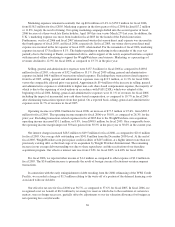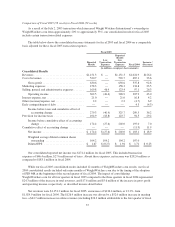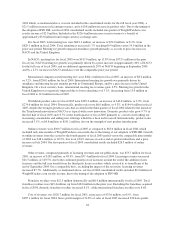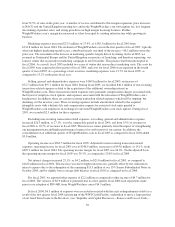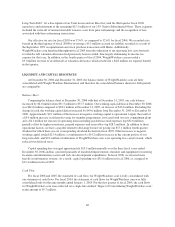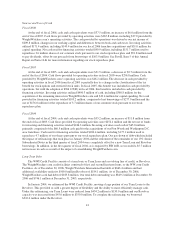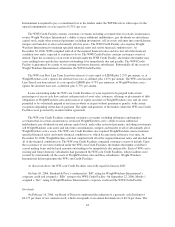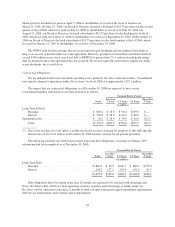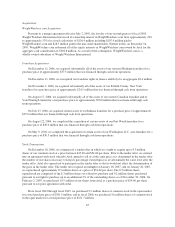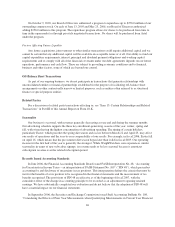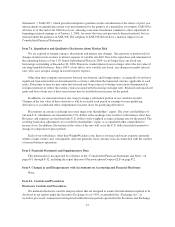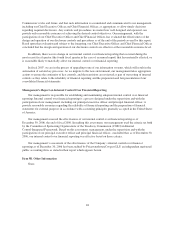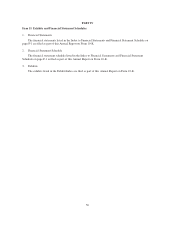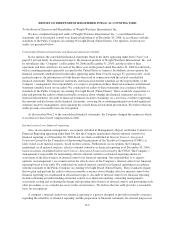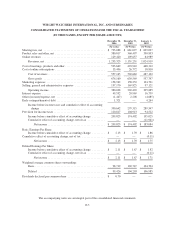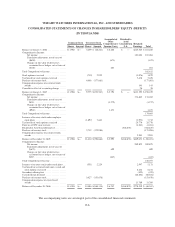WeightWatchers 2006 Annual Report Download - page 59
Download and view the complete annual report
Please find page 59 of the 2006 WeightWatchers annual report below. You can navigate through the pages in the report by either clicking on the pages listed below, or by using the keyword search tool below to find specific information within the annual report.On October 9, 2003, our Board of Directors authorized a program to repurchase up to $250.0 million of our
outstanding common stock. On each of June 13, 2005 and May 25, 2006, our Board of Directors authorized
adding $250.0 million to this program. The repurchase program allows for shares to be purchased from time to
time in the open market or through privately negotiated transactions. No shares will be purchased from Artal
under the program.
Factors Affecting Future Liquidity
Any future acquisitions, joint ventures or other similar transactions could require additional capital and we
cannot be certain that any additional capital will be available on acceptable terms or at all. Our ability to fund our
capital expenditure requirements, interest, principal and dividend payment obligations and working capital
requirements and to comply with all of the financial covenants under our debt agreements depends on our future
operations, performance and cash flow. These are subject to prevailing economic conditions and to financial,
business and other factors, some of which are beyond our control.
Off-Balance Sheet Transactions
As part of our ongoing business, we do not participate in transactions that generate relationships with
unconsolidated entities or financial partnerships established for the purpose of facilitating off-balance sheet
arrangements or other contractually narrow or limited purposes, such as entities often referred to as structured
finance or special purpose entities.
Related Parties
For a discussion of related party transactions affecting us, see “Item 13. Certain Relationships and Related
Transactions” in Part III of this Annual Report on Form 10-K.
Seasonality
Our business is seasonal, with revenues generally decreasing at year end and during the summer months.
Our advertising schedule supports the three key enrollment-generating seasons of the year: winter, spring and
fall, with winter having the highest concentration of advertising spending. The timing of certain holidays,
particularly Easter, which precedes the spring diet season and occurs between March 22 and April 25, may affect
our results of operations and the year-to-year comparability of our results. For example, in fiscal 2006, Easter fell
on April 16, which means that the pre-summer diet season began later than it did in fiscal 2005. Our operating
income for the first half of the year is generally the strongest. While WeightWatchers.com experiences similar
seasonality in terms of new subscriber signups, its revenue tends to be less seasonal because it amortizes
subscription revenue over the related subscription period.
Recently Issued Accounting Standards
In June 2006, the Financial Accounting Standards Board issued FASB Interpretation No. 48, “Accounting
for Uncertainty in Income Taxes – an interpretation of FASB Statement No. 109” (“FIN 48”), which prescribes
accounting for and disclosure of uncertainty in tax positions. This interpretation defines the criteria that must be
met for the benefits of a tax position to be recognized in the financial statements and the measurement of tax
benefits recognized. The provisions of FIN 48 are effective as of the beginning of fiscal 2007, with the
cumulative effect of the change in accounting principle to be recorded as an adjustment to opening retained
earnings. We have substantially completed our evaluation and do not believe that the adoption of FIN 48 will
have a material impact on our financial statements.
In September 2006, the Securities and Exchange Commission issued Staff Accounting Bulletin No. 108,
“Considering the Effects of Prior Year Misstatements when Quantifying Misstatements in Current Year Financial
46


